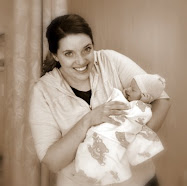Letting babies "cry it out" is an idea that has been around since at least the 1880s when the field of medicine was in a hullaballoo about germs and transmitting infection and so took to the notion that babies should rarely be touched (see
Blum, 2002, for a great review of this time period and attitudes towards childrearing).
In the 20
th century, behaviorist James Watson, interested in making psychology a hard science, took up the crusade against affection as president of the American Psychological Association. He applied the mechanistic paradigm of behaviorism to child rearing, warning about the dangers of too much mother love. The 20
th century was the time when "men of science" were assumed to know better than mothers, grandmothers and families about how to raise a child. Too much kindness to a baby would result in a whiney, dependent, failed human being.
Funny how he got away with this with no evidence to back it up! Instead there is evidence all around (then and now) showing the opposite to be true.
A
government pamphlet from the time recommended that "mothering meant holding the baby quietly, in tranquility-inducing positions" and that "the mother should stop immediately if her arms feel tired" because "the baby is never to inconvenience the adult." Babies older than six months "should be taught to sit silently in the crib; otherwise, he might need to be constantly watched and entertained by the mother, a serious waste of time." (See Blum, 2002.)
Don't these attitudes sound familiar? A
parent reported to me recently that he was encouraged to let his baby cry herself to
sleep so he "could get his life back."
With
neuroscience, we can confirm what our ancestors took for granted---that
letting babies cry is a practice that damages children and their relational capacities in many ways for the long term. We know now that letting babies cry is a good way to make a less intelligent, less healthy but more anxious, uncooperative and alienated person who can pass the same or worse traits on to the next generation.
The discredited behaviorist view sees the baby as an interloper into the life of the parents, an intrusion who must be controlled by various means so the adults can live their lives without too much bother. Perhaps we can excuse this attitude and ignorance because at the time, extended families were being broken up and new parents had to figure out how to deal with babies on their own, an unnatural condition for humanity--we have heretofore raised children in extended families. The parents always shared care with multiple adult relatives.
According a behaviorist view completely ignorant of human development, the child 'has to be taught to be independent.' We can confirm now that forcing "independence" on a baby leads to greater dependence. Instead,
giving babies what they need leads to greater independence later. In anthropological reports of small-band hunter-gatherers, parents took care of every need of babies and young children. Toddlers felt confident enough (and so did their parents) to walk into the bush on their own (see
Hunter-Gatherer Childhoods, edited by Hewlett & Lamb, 2005).
Ignorant behaviorists then and now encourage parents to condition the baby to expect needs NOT to be met on demand, whether feeding or comforting. It's assumed that the adults should 'be in charge' of the relationship. Certainly this might foster a child that doesn't ask for as much help and attention (withdrawing into depression and going into stasis or even wasting away) but it is more likely to foster a whiney, unhappy, aggressive and/or demanding child, one who has learned that one must scream to get needs met. A deep sense of insecurity is likely to stay with them the rest of life.
The fact is that caregivers who habitually respond to the needs of the baby before the baby gets distressed, preventing crying, are more likely to have children who are independent than the opposite (Stein & Newcomb, 1994)
. Soothing care is best from the outset. Once patterns get established, it's much harder to change them.
We should understand the mother and child as a mutually responsive dyad. They are a symbiotic unit that make each other healthier and happier in mutual responsiveness. This expands to other caregivers too.
One strangely popular notion still around today is to let babies 'cry it out' when they are left alone, isolated in cribs or other devices. This comes from a misunderstanding of child and brain development.
- Babies grow from being held. Their bodies get dysregulated when they are physically separated from caregivers. (See here for more.)
- Babies indicate a need through gesture and eventually, if necessary, through crying. Just as adults reach for liquid when thirsty, children search for what they need in the moment. Just as adults become calm once the need is met, so do babies.
- There are many longterm effects of undercare or need-neglect in babies (Dawson et al., 2000).
What does 'crying it out' actually do to the baby and to the dyad?
Neurons die. When the baby is stressed, the toxic hormone cortisol is released. It's a neuron killer. A full-term baby (40-42 weeks), with only 25% of its brain developed, is undergoing rapid brain growth. The brain grows on average three times as large by the end of the first year (and head size growth in the first year is a sign of
intelligence). Who knows what neurons are not being connected or being wiped out during times of extreme
stress? What deficits might show up years later from such regular distressful experience?
Disordered stress reactivity can be established as a pattern for life not only in the brain with the stress response system, but also in the body through the vagus nerve, a nerve that affects functioning in multiple systems (e.g., digestion). For example, prolonged distress in early life, resulting in a poorly functioning vagus nerve, is related disorders as irritable bowel syndrome (Stam et al, 1997). See more about how early stress is toxic for lifelong health from the recent Harvard report,
The Foundations of Lifelong Health are Built in Early Childhood).
Self-regulation is undermined. The baby is absolutely dependent on caregivers for learning how to self-regulate. Responsive care---meeting the baby's needs before he gets distressed---tunes the body and brain up for calmness. When a baby gets scared and a parent holds and comforts him, the baby builds expectations for soothing, which get integrated into the ability to self comfort. Babies don't self-comfort in isolation. If they are left to cry alone, they learn to shut down in face of extensive distress-stop growing, stop feeling, stop trusting (Henry & Wang, 1998).
Trust is undermined. As
Erik Erikson pointed out, the first year of life is a sensitive period for establishing a sense of trust in the world, the world of
caregiver and the world of self. When a baby's needs are met without distress, the child learns that the world is a trustworthy place, that relationships are supportive, and that the self is a positive entity that can get its needs met. When a baby's needs are dismissed or ignored, the child develops a sense of mistrust of relationships and the world. And self-confidence is undermined. The child may spend a lifetime trying to fill the inner emptiness.
Caregiver sensitivity may be harmed. A caregiver who learns to ignore baby crying, will likely learn to ignore the more subtle signaling of the child's needs. Second-guessing intuitions to stop child distress, the adult practices and increasingly learns to "harden the heart." The reciprocity between caregiver and babu is broken by the adult, but cannot be repaired by the young child. The baby is helpless.
Caregiver responsiveness to the needs of the child is related to most if not all positive child outcomes. In our work it is related to
intelligence, empathy, lack of aggression or
depression,
self-regulation, social competence. Because responsiveness is so powerful, we have to control for it in our studies of other
parenting practices and child outcomes. The importance of
caregiverresponsivness is common knowledge in developmental psychology Lack of responsiveness, which "crying it out" represents. then can result in the opposite of the afrementioned positive outcomes.
The 'cry it out' approach seems to have arisen as a solution to the dissolution of extended family life in the 20th century. The vast
wisdom of grandmothers was lost in the distance between households with children and those with the experience and expertise about how to raise them well. The wisdom of keeping babies happy was lost between generations.
But isn't it normal for babies to cry?
No, babies are built to expect the equivalent of an "external womb" after birth (
see Allan Schore, specific references below). What is the external womb? ---being held constantly, breastfed on demand, needs met quickly (I have numerous posts on these things). When babies display discomfort, it signals that a need is not getting met, a need of their rapidly growing systems.
What does extensive baby crying signal? It shows the lack of experience, knowledge and support of the baby's caregivers. To remedy a lack of information in us all, below is a good set of articles about all the things that a baby's cry can signal. We can all educate ourselves about what babies need and the practices that alleviate baby crying. We can help one another to keep it from happening as much as possible.
Check these out:
How to soothe babies:
http://www.babycenter.com/0_12-reasons-babies-cry-and-how-to-soothe-them_9790.bc?page=2
Soothing babies crying "for no reason":http://www.babycenter.com/0_what-to-do-when-your-baby-cries-for-no-reason_10320516.bc
Soothing babies who have "colic":http://www.babycenter.com/0_colic-how-to-cope_1369745.bc
Science of Parenting, an inexpensive, photo-filled, easy-to-read book for parents by Margot Sunderland has much more detail and references on these matters. I keep copies on hand to give to new parents.
More on babies' and children's needs
here,
here,
here.
Giving babies what they need is really a basic right of babies. See
herefor more rights I think babies should expect. And see
here for a new book by Eileen Johnson on the emotional rights of babies.
References
Blum, D. (2002). Love at Goon Park: Harry Harlow and the Science of Affection. New York: Berkeley Publishing (Penguin).
Dawson, G., et al. (2000). The role of early experience in shaping behavioral and
brain development and its implications for social policy. Development and Psychopathology, 12(4), 695-712.
Henry, J.P., & Wang, S. (1998). Effects of early
stress on adult affiliative Behavior,
Psychoneuroendocrinology 23( 8), 863-875.
Schore, A.N. (1997). Early organization of the nonlinear right brain and development of a predisposition to
psychiatric disorders.
Development and Psychopathology,
9, 595-631.
Schore, A.N. (2000).
Attachment and the regulation of the right brain.
Attachment & Human Development, 2, 23-47.
Schore, A.N. (2001). The effects of early relational
trauma on right brain development, affect regulation, and infant mental health.
Infant Mental Health Journal,
22, 201-269.
Stam, R., et al. (1997). Trauma and the gut: Interactions between stressful experience and intestinal function.
Gut.
Stein, J. A., & Newcomb, M. D. (1994). Children's internalizing and externalizing behaviors and maternal health problems.
Journal of Pediatric Psychology, 19(5), 571-593.
Watson, J. B. (1928).
Psychological Care of Infant and Child. New York: W. W. Norton Company, Inc.


